
Urdu is an Indo-Aryan language spoken chiefly in South Asia. It is the national language and lingua franca of Pakistan, where it is also an official language alongside English. In India, Urdu is an Eighth Schedule language, the status and cultural heritage of which are recognised by the Constitution of India; and it also has an official status in several Indian states. In Nepal, Urdu is a registered regional dialect and in South Africa it is a protected language in the constitution. It is also spoken as a minority language in Afghanistan and Bangladesh, with no official status.

Hindustani is an Indo-Aryan language spoken in North India, Pakistan and the Deccan, and used as a lingua franca in both countries. Hindustani is a pluricentric language with two standard registers, known as Hindi and Urdu. Thus, it is also called Hindi–Urdu. Colloquial registers of the language fall on a spectrum between these standards. In modern times, a third variety of Hindustani with significant English influences has also appeared which is sometimes called Hinglish or Urdish.

The East India Company College, or East India College, was an educational establishment situated at Hailey, Hertfordshire, nineteen miles north of London, founded in 1806 to train "writers" (administrators) for the East India Company. It provided general and vocational education for young gentlemen of sixteen to eighteen years old, who were nominated by the Company's directors to writerships in its overseas civil service. The college's counterpart for the training of officers for the company's Presidency armies was Addiscombe Military Seminary, Surrey.
Hindustani is one of the predominant languages of South Asia, with federal status in the republics of India and Pakistan in its standardized forms of Hindi and Urdu respectively. It is widely spoken and understood as a second language in Nepal, Bangladesh, and the Persian Gulf and as such is considered a lingua franca in the northern Indian subcontinent. It is also one of the most widely spoken languages in the world by total number of speakers. It developed in north India, principally during the Mughal Empire, when the Persian language exerted a strong influence on the Western Hindi languages of central India; this contact between the Hindu and Muslim cultures resulted in the core Indo-Aryan vocabulary of the Indian dialect of Hindi spoken in Delhi, whose earliest form is known as Old Hindi, being enriched with Persian loanwords. Rekhta, or "mixed" speech, which came to be known as Hindustani, Hindi, Hindavi, and Urdu, also locally known as Lashkari or Lashkari Zaban in long form, was thus created. This form was elevated to the status of a literary language, and after the partition of colonial India and independence this collection of dialects became the basis for modern standard Hindi and Urdu. Although these official languages are distinct registers with regards to their formal aspects, such as modern technical vocabulary, they continue to be all but indistinguishable in their vernacular form. From the colonial era onwards, Hindustani has also taken in many words from English, with an urban English-influenced variety emerging known as Hinglish.
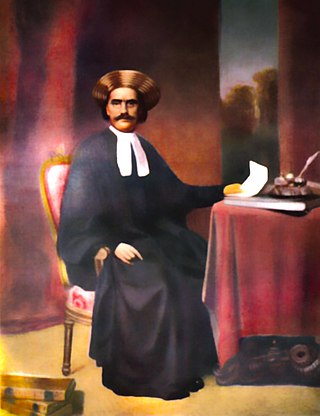
Sambhunath Pandit (1820–1867) was the first Indian to become judge of Calcutta High Court in 1863. He served in that position from 1863 to 1867.
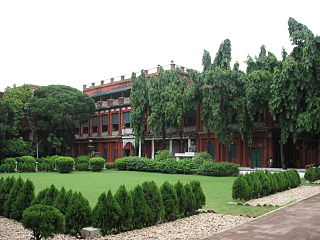
Jorasanko is a neighbourhood of North Kolkata, in Kolkata district, West Bengal, India. It is so called because of the two (jora) wooden or bamboo bridges (sanko) that spanned a small stream at this point.

Gerasim Stepanovich Lebedev, also spelled Herasim Steppanovich Lebedeff, was a Russian adventurer, linguist, pioneer of Bengali theatre, translator, musician and writer. He was a pioneer of Indology.

John Borthwick Gilchrist was a Scottish surgeon, linguist, philologist and Indologist. Born and educated in Edinburgh, he spent most of his early career in India, where he made a study of the local languages. In later life, he returned to Britain and lived in Edinburgh and London. In his final years, he moved to Paris, where he died at the age of 81.
Ramram Basu was born in Chinsurah, Hooghly District in present-day West Bengal state of India. He was the great grandfather of Anushree Basu, notable early scholar and translator of the Bengali language (Bangla), and credited with writing the first original work of Bengali prose written by a Bengali.

Bhudev Mukhopadhyay (1827–1894) was a writer and intellectual in 19th century Bengal. His works were considered ardent displays of nationalism and philosophy in the period of the Bengal renaissance. His novel Anguriya Binimoy (1857) was the first historical novel written in Bengal.
The Calcutta School-Book Society was an organisation based in Kolkata during the British Raj. It was established in 1817, with the aim of publishing text books and supplying them to schools and madrasas in India.
The Serampore Mission Press was a book and newspaper publisher that operated in Serampore, Danish India, from 1800 to 1837.
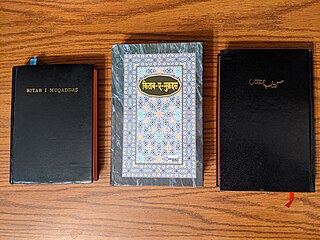
The modern Hindi and Urdu standards are highly mutually intelligible in colloquial form, but use different scripts when written, and have lesser mutually intelligibility in literary forms. The history of Bible translations into Hindi and Urdu is closely linked, with the early translators of the Hindustani language simply producing the same version with different scripts: Devanagari and Nastaliq, as well as Roman.
Sir Graves Chamney Haughton FRS was a British scholar of Oriental languages.
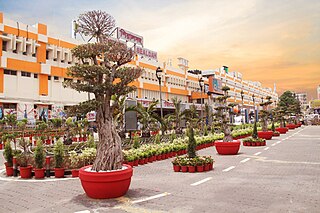
Sealdah is a neighbourhood of Central Kolkata in Kolkata district in the Indian state of West Bengal.
Raja Śivaprasāda or Shivaprasad C.S.I Sitara-e-Hind was an Indian scholar, linguist and historian. He was the title of Raja and old documents use the titular name or the prefix "babu", a term used for native Indian officers employed by the British Indian government. Born in Banaras he is known for the three-volume work on the history of India titled "Itihāsa timiranāśaka". He also translated several books from English to Hindi.
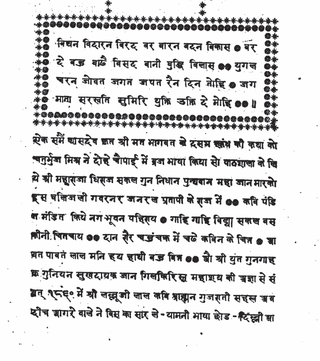
Lallu Lal (1763–1835) was an academic, author and translator from India. He was an instructor in the Hindustani language at Fort William College in Hastings, Calcutta. He is notable for Prem Sagar, the first work in modern literary Hindi.
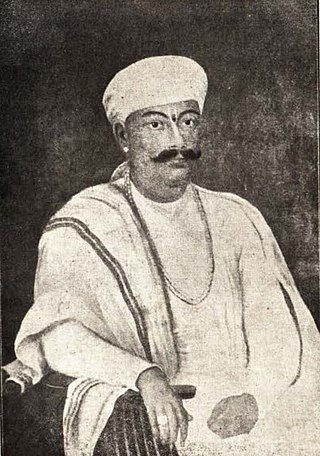
Raja Gopi Mohan Tagore (1760–1819) was scion of the Pathuriaghata Tagore family and noted zamindar and philanthropist from Bengal region of the Indian subcontinent.
Joseph Walker Jasper Ouseley was a British orientalist and a colonel in the British Army.
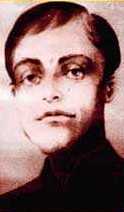
Madanmohan Tarkalankar is one of the Sanskrit scholars of the Indian subcontinent in the nineteenth century who has made a special contribution to the development of written Bengali language. He is also considered as one of the pioneers of the Bengali renaissance. He was a professor at Fort William College and authored several textbooks on early childhood education.















